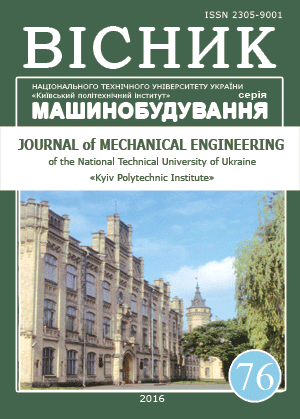RESEARCH STAFF PROCESS OF INTERACTION AND TECHNOLOGICAL ENVIRONMENT IN DEVELOPED CAVITATION
DOI:
https://doi.org/10.20535/2305-9001.2016.76.39735Keywords:
cavitation, ultrasound, technological environment, the contact zone, dissipation, wave resistanceAbstract
Approaches the definition and parameters of the model cavitation technology environment. Found that the technological environment, subdued cavitation processing, is a visco-elastic-plastic body and can be described by the model Binhama-Shvedova. Implemented is the idea to review the contact zone of interaction of the system "cavitation device – technological environment" by determining the balance of power system pressure and stress, surrounded by bubbles emerging in consideration of the fluid model as a system with distributed parameters. As the research is subject to various technological environments the cavitation is shown as viscous and plastic properties, considered taking into account the energy dissipation in cavitating environments, including the contact area on the laws change frequency independent and frequency dependent damping. This approach made it possible to reveal the physical nature of the interaction, receive analytical dependences to establish the basic parameters, including contact pressure and impedance in the contact area «cavitation machine systems – technological environment». Research results select the input impedance compensator length λ/4 for maximum transfer conditions under which the impedance compensator system and coordination. When placing the device between the border and the environment auxiliary layer of material with the acoustic impedance ensured equality acoustic impedance device and transmission line equivalent. Then, a reflection of both boundary layer additionally installed waves are equal in amplitude, thus ensuring maximum transfer of energy to the flow of the process.References
Ляшок, А., Яхно, О., Луговской А. (2013), “Энергетическая модель процесса ультразвукового распыления в тонком слое”, MOTROL, Commission of Motorization and Energetics in Agriculture, Vol. 15, №5, cc. 91–97.
Новицкий, Б.Г. (1983), Применение акустических колебаний в химико-технологических процессах (Процессы и аппараты химической и нефтехимической технологии) [Текст], Химия, Москва, Россия.
Хмелев, В.Н., Леонов, Г.В., Барсуков, Р.В., Цыганок, С.Н., Шалунов, А.В. (2007), Ультразвуковые многофункциональные и специализированные аппараты для интенсификации технологических процессов в промышленности, сельском и домашнем хозяйстве, Изд-во Алт. гос. техн. ун-та, Бийск, Россия.
Huang, Y.D., Liu L., Qiu, J.H., Shao, L. (2002). “Influence of ultrasonic treatment on the characteristics of epoxy resin and the interfacial property of its carbon fiber composites”,. Composit. Sci. Techn., Vol.62, pp. 2153.
Margulis, M.A. (1995). Sonochemistry and Cavitation, Gordon & Breach, London, UK.
Голых, Р.Н., Хмелёв, В.Н., Хмелёв, С.С., Карзакова, К.А. (2013). “Выявление оптимальных режимов и условий ультразвуковой кавитационной обработки высоковязких жидкостей”, Научно-технический вестник Поволжья, №2, cc. 249-251.
Brenner, T. and Grossman, H. “Application of high-power ultrasound in fibre suspensions to increase the strength of paper” [Электронный ресурс]. 40th International Annual Symposium DITP. http://www.cepi.org/system/files/public/ epw-presentations/
Лукьянченко, М., Джелял, А., Струбалин, А. (2013), “Влияние технологических параметров на прочность различных видов вяжущих при ультразвуковой обработке водотвердых суспензий”, MOTROL, Commission of Motorization and Energetics in Agriculture, Vol. 15, №5, cc. 17–22.
Осадчук, П. (2010). “Влияние ультразвукового поля на процес очищения подсолнечного масла”, MOTROL, Commission of Motorization and Energetics in Agriculture, №12, pp. 309–314.
Агранат, Б.А., Башкиров, В.И. (1969), “Влияние статического давления на акустические свойства кавитирующей жидкости”, Акустический журнал, Т.15, вып. 4, cc. 605–607.
Казанцев, В.Ф. (1959), “Движение газовых пузырьков в жидкости под действием сил Бьеркнеса, возникающих в акустическом поле”, Докл. АН СССР, Т. 129, №1, cc. 64–67.
Grum, J.A. (1985), “Sonoluminescence produced by “stable” cavitation”, I bid, Vol. 78, № 1, pp. 137–139.
Когарко, Б.С. (1961), “Об одной модели кавитирующей жидкости”, Доклады АН СССР, Т. 137, вып. 6, cc. 1331–1333.
Луговской, А.Ф., Чухраев, Н.В. (2007), Ультразвуковая кавитация в современных технологиях, Київський університет, Київ, Україна.
Вітенько, Т.М. (2009), Гідродинамічна кавітація у масообмінних, хімічних і біологічних процесах, Видавництво ТДТУ ім. І Пулюя, Тернопіль, Україна.
Литвиненко, О.А. Некоз, О.І. (1999), Кавітаційні пристрої в харчовій, переробній та фармацевтичній промисловості, РВЦ УДХТ, Київ, Україна.
Сыротюк, М.Г. (1969), “Кавитационная прочность воды”, Труды акустического института, Вып. 6, cc. 5 – 15.
Стебновский, С.В. (2001), “Обобщенная реологическая модель кавитирующих конденсированных сред”, Прикладная механика и техническая физика, Т. 42, №3, cc. 116–129.
Долинский, А.А., Иваницкий, Г.К. (2008), Тепломассообмен и гидродинамика в парожидкостных дисперсных средах. Теплофизические основы дискретно-импульсного ввода энергии, Наукова думка, Київ, Україна.
Агранат, Б.А. (1974), Ультразвуковая технология, Металлургия, Москва, Россия.
Берник, І.М., Луговський, О.Ф. (2014), “Встановлення основних параметрів впливу технологічного середовища на робочий процес ультразвукової кавітаційної обробки”, Вібрації в техніці та технологіях, № 3 (75), cc. 121–126.

